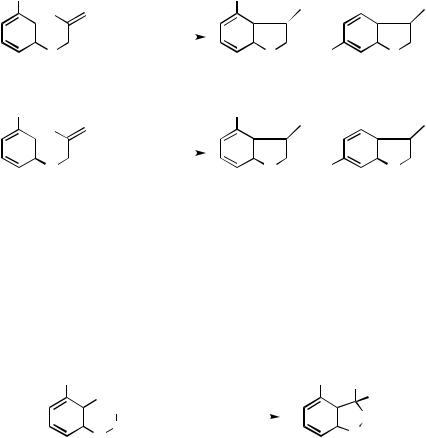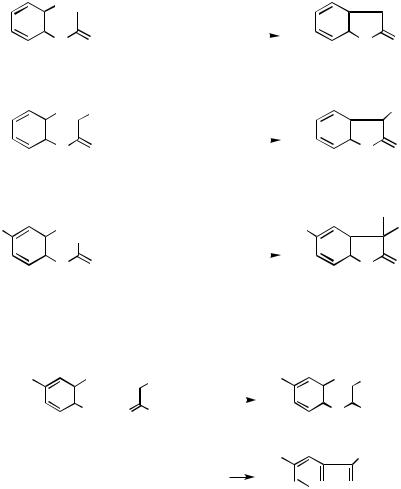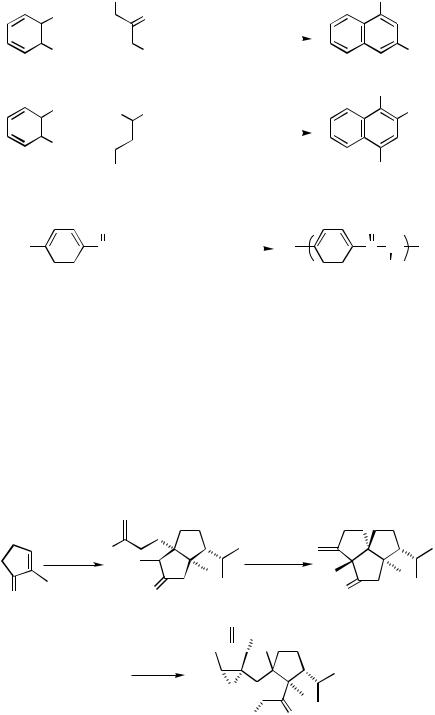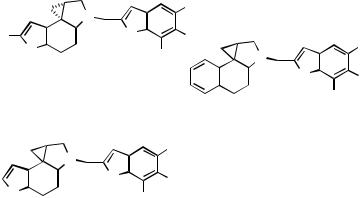

III.2.14.1 -SUBSTITUTION REACTIONS OF ENOLATES |
713 |
The scope of the cyclization reaction has been extended so as to permit the synthesis of five-membered rings, such as benzofurans and indoles, by using Herrmann’s catalyst (1).[65] Unfortunately, however, the regioselectivity observed in the formation of benzofused five-membered rings has been uniformly low (Scheme 24).[66]
HO |
|
|
HO |
|
|
|
|
|
|
||||||||
|
Br |
cat. 1, Cs2CO3 |
|
|
|
|
|
|
|||||||||
|
|
|
|
|
DMA, 70 |
°C, 3d |
|
|
|
|
+ |
|
|
|
|
|
|
|
|
|
|
|
|
|
|
|
|
|
|
|
|
||||
|
|
|
|
|
|
|
|
|
|
|
|
|
|
|
|
|
|
|
|
|
|
|
|
|
|
|
|
|
|
|
|
|
|
|
|
|
O |
|
|
|
O |
HO |
|
O |
|||||||||
|
|
|
|
|
|
41% |
|
|
|
|
41% |
|
|
|
|||
HO |
|
|
HO |
|
|
|
|
|
|
||||||||
|
Br |
cat. 1, Cs2CO3 |
|
|
|
|
|
|
|||||||||
|
|
|
|
|
DMA, 78 |
°C, 1d |
|
|
|
|
|
|
|
|
|
||
|
|
|
|
|
|
|
|
|
|
|
|
|
|
|
|||
|
|
|
|
|
|
|
|
|
|
|
|
|
|
|
|
|
|
|
N |
|
|
|
N |
HO |
|
N |
|||||||||
|
|
|
COOMe |
|
40% |
|
COOMe |
|
40% |
|
COOMe |
||||||
|
|
|
|
|
|
||||||||||||
See Scheme 23 for 1. |
|
|
|
|
|
|
|
|
|||||||||
|
|
|
|
|
|
|
|
|
|
|
|
|
|||||
Scheme 24
Esters, Nitriles, Amides, Imines, and Enamines. Pd-Catalyzed -arylation of extrastabilized enolates and related derivatives containing esters and nitrile groups developed by Uno, Takahashi, and co-workers[47],[48],[50] (Sect. B.i.b.) has been applied to the synthesis of cyclic compounds with moderate success, as indicated by the results shown in Scheme 25.[59]
R |
|
|
|
|
|
|
R |
|
Z |
|
I |
|
|
cat. Pd(PPh3)4, NaH |
|
|
|||
|
|
|
|
|
Z′ |
||||
|
CHZZ′ |
DMF, 130−140 °C |
|
|
Y′ |
||||
|
|
|
|||||||
|
Y′ |
|
|
[59] |
|
|
|
|
|
|
|
|
|
|
|
|
Y |
||
|
Y |
|
|
|
|
|
|
|
|
|
|
|
|
|
|
|
|
|
|
R |
Y |
Y′ |
Z |
Z′ |
|
Yield (%) |
|||
|
|
|
|
|
|
|
|||
H |
CH2 |
CH2 |
COOEt |
COOEt |
|
62 |
|||
Me |
CH2 |
CH2 |
COOEt |
COOEt |
|
75 |
|||
H |
CH2 |
CH2 |
COMe |
COOEt |
|
53 |
|||
H |
CH2 |
CH2 |
CN |
COOEt |
|
38 |
|||
H |
CH2 |
CH2 |
CN |
CN |
|
54 |
|||
H |
CH2 |
(CH2)2 |
CN |
COOEt |
|
49 |
|||
H |
NMe |
CO |
Me |
COOEt |
|
31 |
|||
H |
CH2 |
CO |
H |
COOMe |
|
0 |
|||
Scheme 25

714 |
III Pd-CATALYZED CROSS-COUPLING |
The intramolecular version of Pd-catalyzed -arylation of amides is considerably more favorable than its intermolecular version[29] (Scheme 26).
Imines and enamines react similarly to give indoles generally in good yields[57]
(Scheme 27).
Inter–Intra Tandem Processes Involving Pd-Catalyzed -Arylation of Carbonyl Compounds with 1,2-Dibromoarenes. 1,2-Dibromoarenes have been shown to undergo Pd-catalyzed inter – intra tandem processes leading to the formation of cyclic compounds, as summarized in Scheme 28.[34] In some examples, however, the cyclization process itself does not actually involve Pd-catalyzed -arylation. It instead involves either an interesting diaryl ether formation (Sect. III.3.3) or intramolecular Heck reaction (Sect. IV.2.2).
|
|
Br |
|
|
|
cat. Pd(dba)2 |
|
|
|
|
|
|
||||
|
|
|
|
|
|
|
Phosphine |
|
|
|
|
|
|
|||
|
|
|
|
|
|
|
NaOBu-t |
|
|
|
|
|
|
|||
|
|
N |
O |
|
|
|
|
|
|
|
|
|
|
N |
O |
|
|
|
|
|
|
|
|
|
|
|
|
||||||
|
|
R |
|
|
|
|
|
|
|
|
|
|
|
R |
|
|
|
|
|
|
|
|
|
|
|
R = Me (60%), Bn (66%) |
|
||||||
|
|
Br |
R |
cat. Pd(dba)2 |
|
|
|
|
|
R |
||||||
|
|
Phosphine |
|
|
|
|
|
|
||||||||
|
|
|
|
|
|
|
|
|
|
|
|
|
||||
|
|
|
|
|
|
|
NaOBu-t |
|
|
|
|
|
|
|||
|
|
|
|
|
|
|
|
|
|
|
|
|
|
|
|
|
|
|
N |
O |
|
|
|
|
|
|
|
|
N |
O |
|||
|
|
Me |
|
|
|
|
|
|
|
|
|
|
|
Me |
|
|
|
|
|
|
|
|
|
|
|
|
R = Me (52%), Ph (63%) |
||||||
R |
|
Br |
|
|
|
cat. Pd(dba)2 |
|
R |
|
|
|
|||||
|
Pr-i |
Phosphine |
|
|
|
|
||||||||||
|
|
|
|
|
|
|
|
|
|
|||||||
|
|
|
|
NaOBu-t |
|
|
|
|
|
|
||||||
|
|
|
|
|
|
|
|
|
|
|
|
|
||||
|
|
|
|
|
|
|
|
|
|
|
|
|
|
|
O |
|
|
|
N |
O |
|
|
|
|
|
|
|
|
N |
||||
|
|
Me |
|
|
|
|
|
|
|
|
|
|
|
Me |
|
|
Phosphine = BINAP or dppf |
|
R = H (75%), OMe (80%), CN (83%) |
|
|||||||||||||
|
|
|
|
|
|
|
Scheme 26 |
|
|
|
|
|
|
|||
|
R1 |
I |
R3 cat. Pd(OAc)2 R1 |
|
I |
|
R3 |
|
||||||||
|
|
|
|
+ |
|
|
|
DABCO, DMF |
|
|
|
|
|
|
||
|
|
|
|
|
|
|
|
|
|
|
|
|
||||
|
|
|
|
|
|
|
|
|
|
|
|
|
|
|
|
|
|
|
|
|
NH2 O |
R2 |
|
|
N |
|
R2 |
|
|||||
|
|
|
|
|
|
|
|
|
|
|
|
|
H |
|
|
|
|
|
|
|
|
|
|
|
|
R |
1 |
|
|
|
R3 |
|
|
|
|
|
|
|
|
|
|
|
|
|
|
|
|
|
||

 N
N R2
R2
H 55−82%
Scheme 27

|
|
|
Ph |
|||
|
|
Br |
|
|
|
|
|
|
|
|
|
O |
|
|
|
+ |
|
|
||
|
|
|
|
|||
|
|
|
|
|||
|
|
Br |
|
|
|
|
|
|
|
Ph |
|||
|
|
|
Ph |
|||
X |
Br |
|
|
|
|
|
|
|
+ |
|
|
|
|
|
|
|
|
|
|
|
X |
Br O |
|
|
|
|
|
|
|
|
|
|||
III.2.14.1 -SUBSTITUTION REACTIONS OF ENOLATES |
715 |
|||||||||
cat. Pd(OAc)2, PPh3 |
|
Ph |
|
|||||||
|
|
|
|
|
||||||
K2CO3, o-xylene |
|
|
O |
|
||||||
160 °C, 4 h |
|
|
|
|||||||
|
|
|
|
|
|
64% |
Ph |
|
||
|
|
|
|
|
|
|
||||
|
|
cat. Pd(OAc)2, PPh3 |
|
|
Ph |
|
||||
|
|
X |
|
|
|
|
||||
|
|
Cs2CO3, o-xylene |
|
|
|
|
||||
|
|
|
|
|
|
|
||||
160 |
°C, 2-6 h |
|
|
|
|
Y |
||||
|
Y |
|
|
|
|
|
|
|
|
|
|
|
|
|
|
X |
|
O |
|
||
|
|
|
|
|
|
|
|
|||
|
|
|
|
|
|
|
|
|
|
|
X Y |
Yield (%) |
X |
Y Yield (%) |
|
||||||

 Br HO
Br HO
+
Br
Me
 Br
Br
+
Me  Br
Br
R |
Br |
|
+ R1 |
|
|
|
|
R |
Br |
H |
H |
78 |
H |
Cl |
49 |
H |
Me |
74 |
Me |
H |
69 |
H |
OMe |
75 |
F |
H |
40 |
Bu-t |
|
|
|
|
|
|
|
|
|
|
|
|
Bu-t |
|||||
|
|
|
cat. Pd(OAc)2, PPh3 |
|
O |
|
|
|
|
|
||||||||
|
|
|
Cs2CO3, o-xylene |
|
|
|
|
|
|
|
|
|
|
|||||
|
|
|
160 °C, 6 h |
|
|
|
|
|
|
|
|
|
|
|
|
|||
|
|
|
|
|
|
|
|
|
66% |
|
|
|
|
|
||||
|
|
|
|
|
|
|
|
|
|
|
|
|
|
|||||
O |
cat. Pd(OAc)2, PPh3 |
|
|
|
|
|
|
|
O |
|||||||||
|
|
|
Me |
|
|
|
|
|
||||||||||
|
|
|
Cs2CO3, DMF |
|
|
|
|
|
|
|
||||||||
|
|
|
|
|
|
|
|
|
|
|
|
|
|
|
||||
|
|
|
80 °C, 6 h |
|
|
|
|
|
|
|
|
|
|
|
|
|||
|
|
|
|
|
|
|
|
|
Me |
80% |
|
|
|
|||||
|
|
|
|
|
|
|
|
|
|
|
|
|||||||
|
|
|
|
|
|
|
|
|
|
|
|
|
|
|
|
|
||
|
|
|
|
|
|
|
|
|
|
|
|
|
|
|
|
R1 |
||
|
R1 |
cat. Pd(OAc)2, P(Bu-t)3 |
R |
|
|
|
|
|
||||||||||
|
Cs2CO3, DMF |
|
|
|
|
|
|
CHO |
||||||||||
|
|
|
80 °C, 2−6 h |
|
|
|
|
|
|
|
|
|
|
|
|
|||
|
|
|
CHO |
|
|
|
|
R |
|
|
R1 |
|||||||
|
|
|
|
|
|
|
|
|
||||||||||
|
|
|
|
|
|
|
|
|
|
|
||||||||
|
|
|
|
|
|
R |
R1 |
Yield (%) |
|
|
|
|
|
|||||
|
|
|
|
|
|
|
|
|
|
|
|
|
|
|
|
|
||
|
|
|
|
|
|
H |
Et |
77 |
|
|
|
|
|
|
|
|
||
|
|
|
|
|
|
H |
Me |
45 |
|
|
|
|
|
|
|
|
||
|
|
|
|
|
|
Me |
Et |
50 |
|
|
|
|
|
|
|
|
||
Scheme 28
Similar tandem cyclization reactions of -bromobenzaldehydes have also been reported[36] (Scheme 29). In these reactions, either Br or formyl group may react first. However, their mechanistic details are not very clear.
Finally, it is noteworthy that those haloaryl ketones in which the halogen and carbonyl groups are para to each other cannot cyclize but they can be led to linear polymers, as shown in Scheme 30.[67]

716 |
III Pd-CATALYZED CROSS-COUPLING |
|||
|
|
Ph |
|
cat. Pd(OAc)2, PPh3 |
|
|
|
|
|
|
|
CHO |
O |
K2CO3, o-xylene |
|
|
+ |
|
160 °C, 5 h |
|
|
|
||
|
|
|
|
|
|
|
|
|
|
|
|
Br |
Ph |
|
|
|
CHO OHC |
|
cat. Pd(OAc)2, PPh3 |
|
|
Ph |
Cs2CO3, DMF-toluene |
|
|
|
+ |
|
120 °C, 2 h |
|
|
|
||
|
|
|
|
|
|
|
|
|
|
Br
Ph
 OH
OH
Ph
54%
OH
Ph
|
|
Me |
|
|
|
|
|
62% Me |
|
|
|
|
Scheme 29 |
|
|
|
|
||
|
|
O |
cat. Pd(OAc)2, PR3 |
|
|
|
O |
||
Br |
|
CCH2Pr |
NaOBu-t |
|
|
|
C CH |
||
|
|
|
|
|
|
|
|||
|
[67] |
|
|
|
|
|
|||
|
|
|
|
|
|
|
|
n |
|
|
|
|
|
|
|
|
|
|
Pr |
|
|
|
|
|
PR3 |
Yield (%) |
Mol. Wt. |
||
|
|
|
|
|
|
|
|
||
|
|
|
|
P(Bu-t)3 |
63 |
|
15200 |
||
|
|
|
|
P(o-Tol)3 |
55 |
|
4600 |
||
Scheme 30
D. APPLICATIONS TO NATURAL PRODUCT SYNTHESES
The number of examples of natural product syntheses involving Pd-catalyzed -arylation or -alkenylation of carbonyl and related compounds is still very small. The synthesis of ( )-crinipellin B by Piers and Renaud[62] shown in Scheme 31 may well represent the only bona fide example of the total synthesis of natural products in which the methodology discussed in this section plays a crucial role.
|
several steps I |
cat. Pd(PPh3)4 |
|
KOBu-t, THF |
|
O |
O |
O |
|
84% |
|
|
|
H
O 

steps
(±)-crinipellin B
O 
HO O
Scheme 31

|
|
|
|
|
|
|
|
|
|
|
III.2.14.1 |
-SUBSTITUTION REACTIONS OF ENOLATES 717 |
|||||||||||
|
|
|
|
|
|
|
N |
|
|
|
|
OMe |
|
|
|
|
|||||||
MeOOC |
|
|
|
|
|
|
|
|
|
|
|
|
|
|
|
|
|
|
|||||
|
|
|
|
|
|
|
|
|
|
|
|
|
|
|
|
|
|
||||||
|
|
|
|
|
|
|
|
|
|
|
|
|
|
|
|
|
|
||||||
|
|
|
|
|
|
|
|
|
|
|
|
|
|
|
|
|
|
|
|
|
|
||
|
|
|
|
|
|
|
|
|
|
|
|
|
|
|
|
|
|
|
|
|
|
||
|
|
|
|
|
|
|
|
|
O N |
OMe |
|
|
|
OMe |
|||||||||
|
N |
|
|
|
|
|
|
|
|
|
|
|
H |
OMe |
N |
|
|
||||||
|
H |
|
|
|
|
|
|
|
|
|
|
|
|
|
|
||||||||
|
|
|
O |
|
|
|
|
|
|
|
|
|
|
|
|
|
|||||||
|
|
|
|
|
|
|
|
|
|
|
|
|
|
|
|
|
|||||||
|
|
|
|
|
|
|
|
|
|
|
|
|
O N |
OMe |
|||||||||
|
|
|
|
|
|
|
|
|
|
|
|
|
|
|
|
|
|
|
|
||||
|
|
duocarmycin SA |
|
|
|
|
|
|
|
H |
OMe |
||||||||||||
|
|
|
|
|
|
|
|
|
|
||||||||||||||
|
|
|
|
|
|
|
|
|
|
|
|
|
|
|
|
O |
2 |
|
|||||
|
|
|
|
|
|
|
|
|
|
|
|
|
|
|
|
|
|
|
|
|
|||
|
|
|
|
|
|
N |
|
|
|
|
|
|
|
OMe |
|
|
|
|
|||||
|
|
|
|
|
|
|
|
|
|
|
|
|
3 (X = O) |
4 (X = S) |
|
||||||||
|
|
|
|
|
|
|
|
|
|
|
|
|
|
||||||||||
|
|
|
|
|
|
|
|
|
|
|
|
|
|||||||||||
|
|
|
|
|
|
|
|
|
|
|
|
|
N |
|
|
|
|
|
|
|
|
|
|
|
|
|
|
|
|
|
|
O |
|
|
OMe |
|
|
|
|
||||||||
X |
|
|
H |
|
|
OMe |
|
|
|
|
|
|
O |
||
|
|
|
Scheme 32 |
Although not naturally occurring, benzene, furan, and thiophene analogs of CC1065/duocarmycin pharmacophores (2 – 4) (Scheme 32) have been synthesized via Pdcatalyzed -arylation,[63] as briefly presented in Scheme 21.
REFERENCES
[1]H. O. House, Modern Synthetic Reactions, 2nd ed., W. A. Benjamin, Menlo Park, CA, 1972, Chap. 9.
[2]M. E. Jung, Tetrahedron, 1976, 32, 3 – 31.
[3]R. A. Rossi and J. F. Bunnett, J. Am. Chem. Soc., 1972, 94, 683.
[4]M. G. Moloney and J. T. Pinhey, J. Chem. Soc. Chem. Commun., 1984, 965.
[5]S. Hashimoto, T. Shinoda, and S. Ikegami, J. Chem. Soc. Chem. Commun., 1988, 1137.
[6]S. Hashimoto, Y. Miyazaki, and S. Ikegami, Synlett, 1996, 324.
[7]T. C. T. Chang, M. Rosenblum, and S. B. Samuels, J. Am. Chem. Soc., 1980, 102, 5931.
[8]P. F. Hudrlik and A. K. Kulkarni, J. Am. Chem. Soc., 1981, 103, 6251.
[9]P. A. Wender, D. A. Holt, and S. M. Sieburth, J. Am. Chem. Soc., 1983, 105, 3348.
[10]E. Negishi, Z. Tan, S. Y. Liou, and B. Liao, Tetrahedron, 2000, 56, 10197.
[11]W. Adam and P. Klug, Synthesis, 1994, 557.
[12]R. F. Heck, J. Am. Chem. Soc., 1968, 90, 5535.
[13]R. Saito, T. Izumi, and A. Kasahara, Bull. Chem. Soc. Jpn., 1973, 46, 1776.
[14]L. S. Hegedus, R. E. Williams, M. A. McGuire, and T. Hayashi, J. Am. Chem. Soc., 1980, 102, 4973.
[15]M. F. Semmelhack, R. D. Stauffer, and T. D. Rogerson, Tetrahedron Lett., 1973, 4519.
[16]M. F. Semmelhack, B. P. Chong, R. D. Stauffer, T. D. Rogerson, A. Chong, and L. D. Jones,
J. Am. Chem. Soc., 1975, 97, 2507.
[17]J. F. Fauvarque and A. Jutand, J. Organomet. Chem., 1977, 132, C17.
[18]A. A. Millard and M. W. Rathke, J. Am. Chem. Soc., 1977, 99, 4833.
[19]M. Kosugi, M. Suzuki, I. Hagiwara, K. Goto, K. Saitoh, and T. Migita, Chem. Lett., 1982, 939.
[20]I. Kuwajima and H. Urabe, J. Am. Chem. Soc., 1982, 104, 6831.
718III Pd-CATALYZED CROSS-COUPLING
[21]M. Kosugi, I. Hagiwara, T. Sumiya, and T. Migita, J. Chem. Soc. Chem. Commun., 1983, 344.
[22]M. Kosugi, I. Hagiwara, and T. Migita, Chem. Lett., 1983, 839.
[23]M. Kosugi, I. Hagiwara, T. Sumiya, and T. Migita, Bull. Chem. Soc. Jpn., 1984, 57, 242.
[24]M. Kosugi, I. Takano, M. Sakurai, H. Sano, and T. Migita, Chem. Lett., 1984, 1221.
[25]M. Palucki and S. L. Buchwald, J. Am. Chem. Soc., 1997, 119, 11108.
[26]J. Åhman, J. P. Wolfe, M. V. Troutman, M. Palucki, and S. L. Buchwald, J. Am. Chem. Soc., 1998, 120, 1918.
[27]J. M. Fox, X. Huang, A. Chieffi, and S. L. Buchwald, J. Am. Chem. Soc., 2000, 122, 1360.
[28]B. C. Hamann and J. F. Hartwig, J. Am. Chem. Soc., 1997, 119, 12382.
[29]K. H. Shaughnessy, B. C. Hamann, and J. F. Hartwig, J. Org. Chem., 1998, 63, 6546.
[30]M. Kawatsura and J. F. Hartwig, J. Am. Chem. Soc., 1999, 121, 1473.
[31]T. Satoh, Y. Kawamura, M. Miura, and M. Nomura, Angew. Chem. Int. Ed. Engl., 1997, 36, 1740.
[32]Y. Terao, T. Satoh, M. Miura, and M. Nomura, Tetrahedron Lett., 1998, 39, 6203.
[33]T. Satoh, J. Inoh, Y. Kawamura, M. Miura, and M. Nomura, Bull. Chem. Soc. Jpn., 1998, 71, 2239.
[34]Y. Terao, T. Satoh, M. Miura, and M. Nomura, Bull. Chem. Soc. Jpn., 1999, 72, 2345.
[35]T. Satoh, Y. Kametani, Y. Terao, M. Miura, and M. Nomura, Tetrahedron Lett., 1999, 40, 5345.
[36]Y. Terao, T. Satoh, M. Miura, and M. Nomura, Tetrahedron, 2000, 56, 1315.
[37]J. H. Simpson and J. K. Stille, J. Org. Chem., 1985, 50, 1759.
[38]J. F. Fauvarque and A. Jutand, J. Organomet. Chem., 1979, 177, 273.
[39]J. F. Fauvarque and A. Jutand, J. Organomet. Chem., 1981, 209, 109.
[40]T. Sato, T. Itoh, and T. Fujisawa, Chem. Lett., 1982, 1559.
[41]F. Orsini and F. Pelizzoni, Synth. Commun., 1987, 17, 1389.
[42]F. Orsini, F. Pelizzoni, and L. M. Vallarino, J. Organomet. Chem., 1989, 367, 375.
[43]M. Kosugi, Y. Negishi, M. Kameyama, and T. Migita, Bull. Chem. Soc. Jpn., 1985, 58, 3383.
[44]M. Kosugi, M. Ishiguro, Y. Negishi, H. Sano, and T. Migita, Chem. Lett., 1984, 1511.
[45]C. Carfagna, A. Musco, G. Sallese, R. Santi, and T. Fiorani, J. Org. Chem., 1991, 56, 261.
[46]R. Galarini, A. Musco, R. Pontellini, and R. Santi, J. Mol. Catal., 1992, 72, L11.
[47]M. Uno, K. Seto, and S. Takahashi, J. Chem. Soc. Chem. Commun., 1984, 932.
[48]M. Uno, K. Seto, M. Masuda, W. Ueda, and S. Takahashi, Tetrahedron Lett., 1985, 26, 1553.
[49]I. M. Blake, H. L. Anderson, D. Beljonne, J. L. Brédas, and W. Clegg, J. Am. Chem. Soc., 1998, 120, 10764.
[50]M. Uno, K. Seto, W. Ueda, M. Masuda, and S. Takahashi, Synthesis, 1985, 506.
[51]T. Sakamoto, E. Katoh, Y. Kondo, and H. Yamanaka, Heterocycles, 1988, 27, 1353.
[52]T. Sakamoto, Y. Kondo, T. Suginome, S. Ohba, and H. Yamanaka, Synthesis, 1991, 552.
[53]M. T. Reetz, K. Wanninger, and M. Hermes, Chem. Commun., 1997, 535.
[54]E. Negishi, H. Matsushita, S. Chatterjee, and R. A. John, J. Org. Chem., 1982, 47, 3188.
[55]E. Negishi and R. A. John, J. Org. Chem., 1983, 48, 4098.
[56]D. D. Hennings, S. Iwasa, and V. H. Rawal, J. Org. Chem., 1997, 62, 2.
[57]C. Chen, D. R. Lieberman, R. D. Larsen, T. R. Verhoeven, and P. J. Reider, J. Org. Chem., 1997, 62, 2676.
[58]M. A. Ciufolini and M. E. Browne, Tetrahedron Lett., 1987, 28, 171.
III.2.14.1 -SUBSTITUTION REACTIONS OF ENOLATES |
719 |
[59]M. A. Ciufolini, H. B. Qi, and M. E. Browne, J. Org. Chem., 1988, 53, 4149.
[60]H. Muratake and M. Natsume, Tetrahedron Lett., 1997, 38, 7581.
[61]E. Piers and P. C. Marais, J. Org. Chem., 1990, 55, 3454.
[62]E. Piers and J. Renaud, J. Org. Chem., 1993, 58, 11.
[63]H. Muratake, A. Hayakawa, and M. Natsume, Tetrahedron Lett., 1997, 38, 7577.
[64]H. Muratake and H. Nakai, Tetrahedron Lett., 1999, 40, 2355.
[65]M. Beller, H. Fischer, W. A. Herrmann, K. Öfele, and C. Brossmer, Angew. Chem. Int. Ed. Engl., 1995, 34, 1848.
[66]D. D. Hennings, S. Iwasa, and V. H. Rawal, Tetrahedron Lett., 1997, 38, 6379.
[67]D. Wang and Z. Wu, Chem. Commun., 1999, 529.
